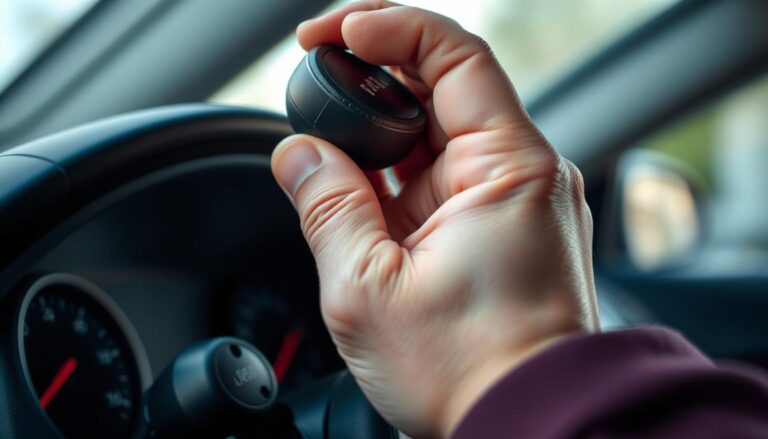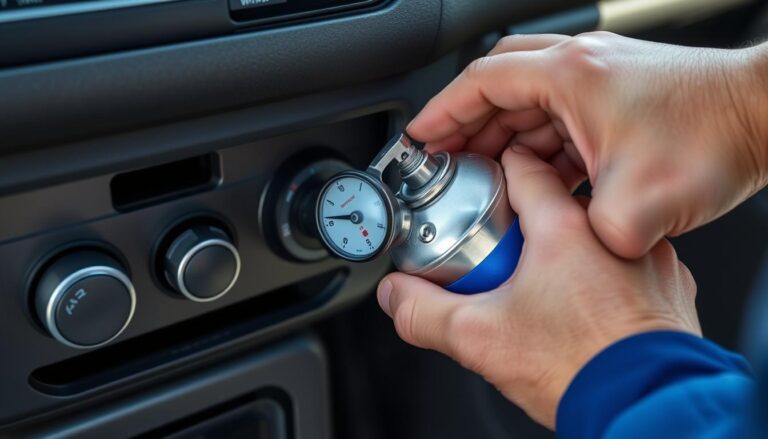Vehicle safety is paramount, and one critical aspect of maintaining it is ensuring the brake system is functioning correctly. Brake caliper piston issues can lead to significant safety hazards if not addressed promptly.
When a caliper piston won’t compress, it can be a sign of an underlying problem that needs immediate attention. Understanding the reasons behind caliper piston compression problems is crucial for effective diagnosis and repair.
Addressing these issues not only ensures vehicle safety but also prevents further damage to the brake system. In this guide, we will explore the common causes of caliper piston compression problems and provide solutions to fix them.
Key Takeaways
- Understanding the importance of addressing brake caliper piston issues promptly.
- Identifying common causes of caliper piston compression problems.
- Learning effective solutions to fix caliper piston compression issues.
- Preventing further damage to the brake system.
- Ensuring vehicle safety through proper brake maintenance.
Understanding Brake Caliper Pistons and Their Function
Brake caliper pistons play a crucial role in the vehicle’s braking system, and understanding their function is essential for maintaining safe and effective brakes. The brake caliper pistons are responsible for applying pressure to the brake pads, which in turn contact the brake rotor to slow or stop the vehicle.
What Are Brake Caliper Pistons?
Brake caliper pistons are metal or ceramic components located within the brake caliper, a critical part of the vehicle’s braking system. They are designed to move back and forth within the caliper, applying pressure to the brake pads when the brake pedal is pressed. The pistons are typically sealed with a rubber boot to prevent debris and moisture from entering the caliper.
How Caliper Pistons Work in the Braking System
The operation of caliper pistons is closely tied to the hydraulic braking system. When the driver presses the brake pedal, brake fluid is pressurized, pushing the pistons outward. This movement forces the brake pads against the rotor, creating the friction needed to slow or stop the vehicle. The pistons retract when the brake pedal is released, allowing the brake pads to disengage from the rotor.
| Component | Function |
|---|---|
| Brake Caliper Pistons | Apply pressure to brake pads |
| Brake Pads | Contact brake rotor to slow or stop vehicle |
| Brake Fluid | Transfers pressure through hydraulic system |
Signs of Caliper Piston Compression Issues
Issues with caliper piston compression can manifest in various ways, including spongy brake pedals, uneven braking, or brake drag. Inspecting the brake caliper and pistons regularly can help identify potential problems early on. Common signs include visible corrosion on the pistons, seized or stuck pistons, or damaged seals and boots.
Caliper Piston Won’t Compress: Reasons Behind it and Fixes
The inability to compress a caliper piston is often a symptom of a larger issue within the braking system. This problem can manifest due to various reasons, ranging from corrosion and seized pistons to damaged seals and hydraulic system malfunctions.
Corrosion and Rust Formation
Corrosion and rust are common issues that can prevent a caliper piston from compressing. When brake components are exposed to moisture and salt, it can lead to the formation of rust, which hinders the piston’s movement. Regular cleaning and inspection can help mitigate this issue.
To address corrosion, one can use a rust-inhibiting coating on the caliper and piston. Ensuring the brake system is dry and free from debris also helps prevent rust formation.
Seized or Stuck Pistons
A seized or stuck piston is another reason for compression failure. This can occur due to lack of maintenance, causing the piston to become stuck in the caliper bore. Using a piston retrieval tool can help in carefully freeing the stuck piston without causing damage.
Damaged Seals and Boots
Damaged seals and boots around the caliper piston can also lead to compression issues. Inspecting these components for any signs of wear or damage is crucial. Replacing damaged seals and boots with new ones can resolve the problem.
Debris and Foreign Material Buildup
Debris and foreign material accumulating within the caliper can obstruct the piston’s movement. Regularly cleaning the caliper and surrounding area can prevent this issue. Using compressed air to blow out debris is an effective method.
Hydraulic System Issues
Problems within the hydraulic system, such as air in the brake lines or faulty master cylinders, can also affect caliper piston compression. Bleeding the brake system to remove air and inspecting the master cylinder for any faults are necessary steps.
| Issue | Cause | Fix |
|---|---|---|
| Corrosion/Rust | Moisture exposure | Rust-inhibiting coating, regular cleaning |
| Seized/Stuck Piston | Lack of maintenance | Piston retrieval tool |
| Damaged Seals/Boots | Wear and tear | Replace with new seals/boots |
| Debris Buildup | Foreign material accumulation | Cleaning, compressed air |
| Hydraulic System Issues | Air in brake lines, faulty master cylinder | Bleed brake system, inspect/replace master cylinder |
Understanding these potential causes and applying the appropriate fixes can help resolve caliper piston compression issues effectively.

Step-by-Step Guide to Compressing Caliper Pistons
The process of compressing caliper pistons involves several steps that must be followed meticulously to ensure the brake system functions correctly and safely.
Safety Precautions Before Starting
Before you begin compressing caliper pistons, it’s crucial to take necessary safety precautions. Wear protective gear such as gloves and safety glasses to prevent injury from potential debris or chemical splashes. Ensure the vehicle is securely supported on jack stands and apply the parking brake.
Tools and Materials Needed
To compress caliper pistons effectively, you’ll need the right tools and materials. These include:
- C-clamps or specialized caliper piston compression tools
- Brake fluid reservoir cap
- New brake pads
- Lubricant for the caliper pins
- Safety glasses and gloves
Preparing the Brake System
Preparation is key to successfully compressing caliper pistons. Start by removing the wheel and caliper. Carefully take out the old brake pads and inspect the caliper for any signs of wear or damage. Clean the caliper and surrounding area to prevent any debris from interfering with the compression process.
Proper Compression Techniques
Compressing the caliper piston requires careful technique to avoid damaging the piston or the caliper. There are two primary methods:
Using C-Clamps Method
The C-clamp method involves using a C-clamp to push the piston back into the caliper. Place the C-clamp on the piston and tighten it slowly until the piston is fully compressed.
Using Specialized Caliper Tools
Specialized caliper tools are designed specifically for compressing caliper pistons. These tools provide a more controlled and safe method of compression, reducing the risk of damage to the caliper or piston.
Troubleshooting Common Compression Difficulties
Despite careful preparation, difficulties can arise during the compression process. Common issues include:
- Stuck or seized pistons
- Damaged or worn-out seals
- Debris or corrosion within the caliper
Addressing these issues promptly and correctly is crucial to ensuring the brake system functions properly.

Advanced Solutions and Preventative Maintenance
Beyond basic troubleshooting, advanced solutions and regular maintenance play a pivotal role in managing caliper piston compression problems. As brake systems are critical for vehicle safety, understanding these advanced strategies is essential for optimal performance and longevity.
Caliper Rebuild Process
Rebuilding a caliper involves several key steps, including disassembly, cleaning, inspection, and replacement of worn or damaged parts. The caliper rebuild process requires precision to ensure that all components are properly restored or replaced. This process can be cost-effective and is often considered a viable alternative to full caliper replacement.
When to Replace vs. When to Repair
Deciding whether to replace or repair a caliper depends on the extent of the damage. If the caliper’s body is severely corroded or damaged, replacement is usually the safer option. However, if the issue is limited to worn seals or pistons, a rebuild might be sufficient. Understanding the difference is crucial for making an informed decision.
Regular Maintenance to Prevent Compression Issues
Regular maintenance is key to preventing caliper piston compression problems. This includes regular inspections of the brake system, cleaning, and lubrication of caliper components, and timely replacement of brake fluid. By adopting a proactive approach, many common issues can be avoided, ensuring the brake system operates smoothly.
Professional Assistance: When to Seek Help
While many maintenance tasks can be performed by vehicle owners, certain situations require professional assistance. If you’re unsure about the diagnosis or the repair process, or if the problem persists after attempting repairs, it’s advisable to seek help from a qualified mechanic. They can provide the necessary expertise to resolve complex issues.
Conclusion
Understanding and addressing caliper piston compression problems is crucial for maintaining a vehicle’s braking system. The issues related to caliper piston compression can lead to significant safety risks if not properly managed.
A caliper piston compression summary highlights the importance of identifying the reasons behind compression issues, such as corrosion, seized pistons, and damaged seals. By understanding these causes, vehicle owners can take appropriate measures to rectify the problems.
In conclusion, addressing caliper piston compression issues requires a comprehensive approach that includes proper diagnosis, maintenance, and repair. By following the guidelines outlined in this article, individuals can ensure their vehicle’s braking system operates effectively and safely.
Final thoughts on caliper piston compression emphasize the need for regular maintenance and inspections to prevent issues before they arise, ensuring the longevity and reliability of the vehicle’s braking system.
FAQ
What are the common signs of caliper piston compression issues?
Common signs include brake drag, uneven brake wear, and a spongy brake pedal. Additionally, you may notice brake fluid leaks or corrosion around the caliper.
Can I compress caliper pistons without specialized tools?
While it’s possible to compress caliper pistons using C-clamps, specialized caliper tools are recommended for a safer and more efficient process.
How often should I inspect my brake calipers for compression issues?
Regular inspections are recommended during routine brake maintenance, typically every 10,000 to 15,000 miles, or when replacing brake pads.
What causes corrosion on brake caliper pistons?
Corrosion on brake caliper pistons is often caused by exposure to moisture, road salt, and debris. Regular cleaning and maintenance can help prevent corrosion.
Can I rebuild my brake calipers myself?
Rebuilding brake calipers requires specialized knowledge and tools. While it’s possible to do it yourself, it’s often recommended to seek professional assistance for complex repairs.
How do I know when to replace versus repair my brake calipers?
The decision to replace or repair brake calipers depends on the extent of the damage. If the caliper is severely corroded or damaged, replacement is usually the best option.
What are the benefits of regular brake maintenance?
Regular brake maintenance can help prevent compression issues, ensure even brake wear, and maintain overall vehicle safety.
Can hydraulic system issues cause caliper piston compression problems?
Yes, hydraulic system issues, such as air in the brake lines or faulty master cylinders, can cause caliper piston compression problems.


